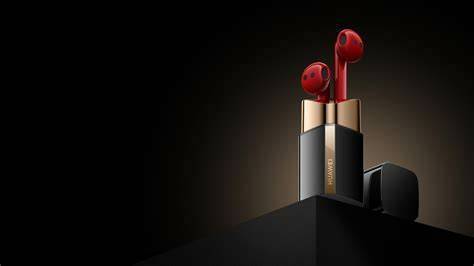Psst. Hey Kid. Want A Lipstick? Huawei Slips New Earbuds Into Cosmetics Case

Marketing strategies have taken an interesting turn for Huawei this week as it launched a wireless noise-cancelling earbud in the Chinese market that is designed to look like a lipstick.
The Chinese tech giant announced the Huawei FreeBuds Lipstick last month, hawking it as combining "luxury design with cutting-edge technology." The company said the gold-accented cylinder was designed by a multinational crew from the fashion, automotive and digital industries.
The product itself has AI-adaptive audio technology pitched as intelligently optimizing sound quality for the price of ¥1,699 ($266, £198, €235). Other aspects of the earbuds include an ergonomic shape designed through extensive stress testing, support for EMUI 12+ device OS, proximity Bluetooth pairing, dual device connections, on-ear touch controls via the Huawei AI Life App, up to 48 kHz HD recording, and up to 22 hours of music playback when the noise cancellation feature is disengaged.
But let's face it, it's mostly about that "smooth as a mirror" charging case with a magnetic fastener that clicks like a lipstick case, packaged up in a "scented gift box" that opens up to reveal a very lipstick-y shade of red.
While the product may seem gimmicky, at the very least Huawei seeks to differentiate itself from other existing products, unlike its earbuds in the past, which looked eerily like products from a company whose name rhymes with "Dapple."
It's an interesting choice of direction, and one that may work for the Chinese market. Meanwhile, earbud trends in the US seem to be headed in the opposite direction - less Sex in the City and more towards a "normcore" approach. The Wall Street Journal reported this week about the incoming trend for "retro" wired earbuds, complete with musing on whether the trend is a form of virtue signaling or an attempt to keep strangers from approaching by making it dead obvious the wearer is otherwise engaged.
Other products unveiled by Huawei this week include a ¥1,488 ($233, £173, €206) WATCH GT3, wearable sports products that support heart rate, sleep and pressure monitoring with upgrade potential for altitude sickness, atrial fibrillation and sleep apnea-risk screening (that's when you suddenly stop breathing at night while you sleep – if you're known for snoring and then suddenly "stopping", go to the doc and get that checked out), and a ¥2,188 ($243, £255, €303) WATCH GT Runner, which provides comprehensive evaluation for physical fitness and fatigue in runners to help them better train.
There was also the ¥5,999 ($940, £698, €830) MateBook E, a 2-in-1 tablet with a bundled smart magnetic keyboard. The device has a 12.6 inch OLED screen and runs on Windows 11.
Smartphones were not left behind, as Huawei launched a ¥18,999 ($298, £220, €263) 5G smartphone with 12GB RAM, 512GB storage and a folding screen, called Collector's Edition Mate X2. Huawei claims the unit sold out in seconds. The foldable uses a Kirin 9000 chipset and HarmonyOS 2 software.
The all-in-one desktop MateStation X was also brought into the market, inclusive of a 28.2 inch IPS LCP display.
Lastly, there was Huawei's VR Glass 6DoF, a two dedicated controller 90-degree field of view gaming VR headset.
Attempts at product diversification have become increasingly important in the face of US sanctions. The US has not been shy about targeting Huawei in particular since its 5G infrastructure kit was banned both in the US and the UK.
The bans and sanctions keep coming, the latest last week as the US Federal Communications Commission (FCC) closed what their commissioner literally called the "Huawei loophole" by disallowing US regulators from even considering the issuance of new telecom equipment licences for companies deemed security threats.
Huawei has taken many measures to stay profitable and relevant since then, including selling off parts of its business.
In Q2 of this year, Huawei reported a 29.5 per cent year-on-year revenue plunge which the company's chairman Eric Xu attributed to "a decline in revenue from our consumer business caused by external factors." The company then saw a 38 per cent year-on-year slide in Q3 revenue, although it maintained overall profitability. ®
From Chip War To Cloud War: The Next Frontier In Global Tech Competition
The global chip war, characterized by intense competition among nations and corporations for supremacy in semiconductor ... Read more
The High Stakes Of Tech Regulation: Security Risks And Market Dynamics
The influence of tech giants in the global economy continues to grow, raising crucial questions about how to balance sec... Read more
The Tyranny Of Instagram Interiors: Why It's Time To Break Free From Algorithm-Driven Aesthetics
Instagram has become a dominant force in shaping interior design trends, offering a seemingly endless stream of inspirat... Read more
The Data Crunch In AI: Strategies For Sustainability
Exploring solutions to the imminent exhaustion of internet data for AI training.As the artificial intelligence (AI) indu... Read more
Google Abandons Four-Year Effort To Remove Cookies From Chrome Browser
After four years of dedicated effort, Google has decided to abandon its plan to remove third-party cookies from its Chro... Read more
LinkedIn Embraces AI And Gamification To Drive User Engagement And Revenue
In an effort to tackle slowing revenue growth and enhance user engagement, LinkedIn is turning to artificial intelligenc... Read more

